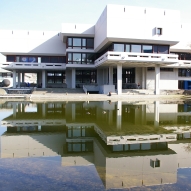Zusammenfassung
In recent years, reduced-intensity conditioning (RIC) regimens before allogeneic stem cell transplantation (SCT) are increasingly used in patients not eligible for conventional conditioning. We did a retrospective, multicenter analysis to assess the feasibility of conditioning with fludarabine and treosulfan before allogeneic SCT in multiple myeloma patients. Thirty-four patients with a median ...
Zusammenfassung
In recent years, reduced-intensity conditioning (RIC) regimens before allogeneic stem cell transplantation (SCT) are increasingly used in patients not eligible for conventional conditioning. We did a retrospective, multicenter analysis to assess the feasibility of conditioning with fludarabine and treosulfan before allogeneic SCT in multiple myeloma patients. Thirty-four patients with a median age of 51.5 years were included in the analysis. All patients underwent myeloablation after conditioning followed by stable engraftment, and 29 of 31 evaluable patients (94%) showed early complete hematopoietic chimerism. Non-hematological toxicities were limited and encompassed mainly fever in neutropenia and infections. Grade II-IV acute and chronic graft-versus-host disease was observed in 33 and 39%, respectively. With a median follow-up of 708 days (range 60-1729 days), the median progression-free survival was 180 days. The treatment-related mortality was 10% on day 100 and 25% after 1 year. The median overall survival has not yet been reached. Our data indicate that conditioning with fludarabine and treosulfan before allogeneic SCT is feasible in intensively pretreated multiple myeloma patients and leads to stable engraftment and complete hematopoietic chimerism. Randomized trials are warranted to determine if this approach might be incorporated in an algorithm of multiple myeloma treatment.




 Altmetric
Altmetric